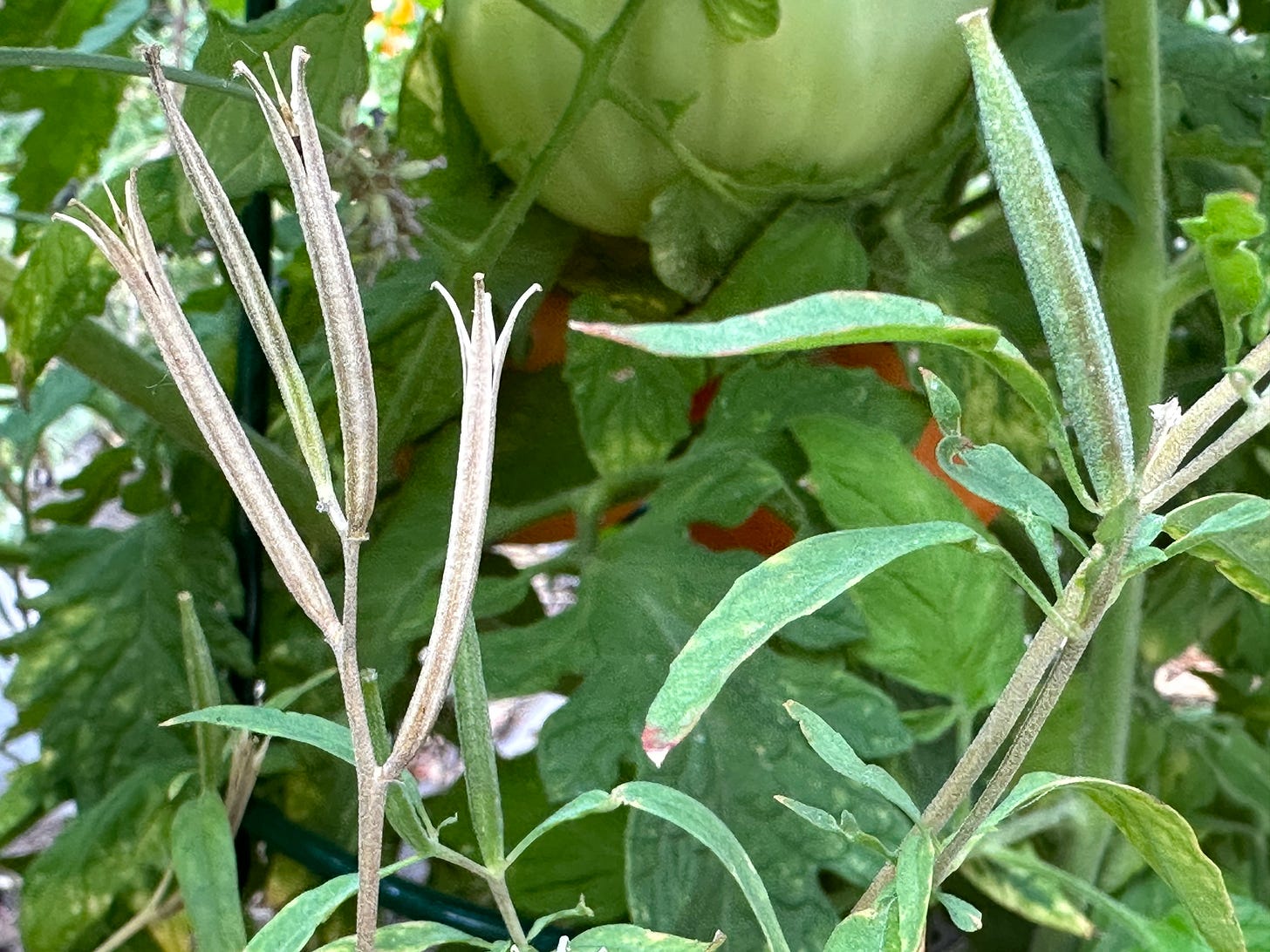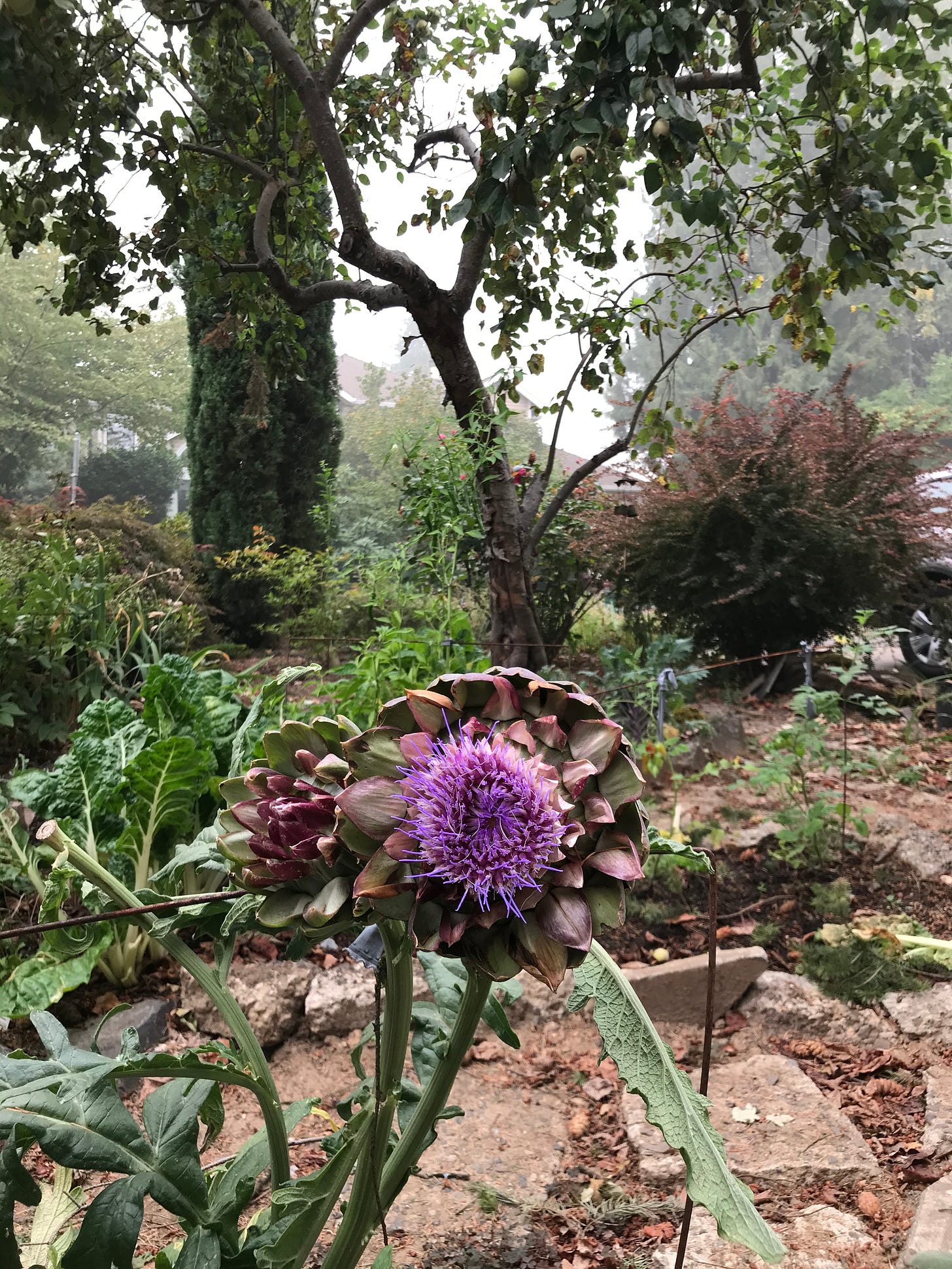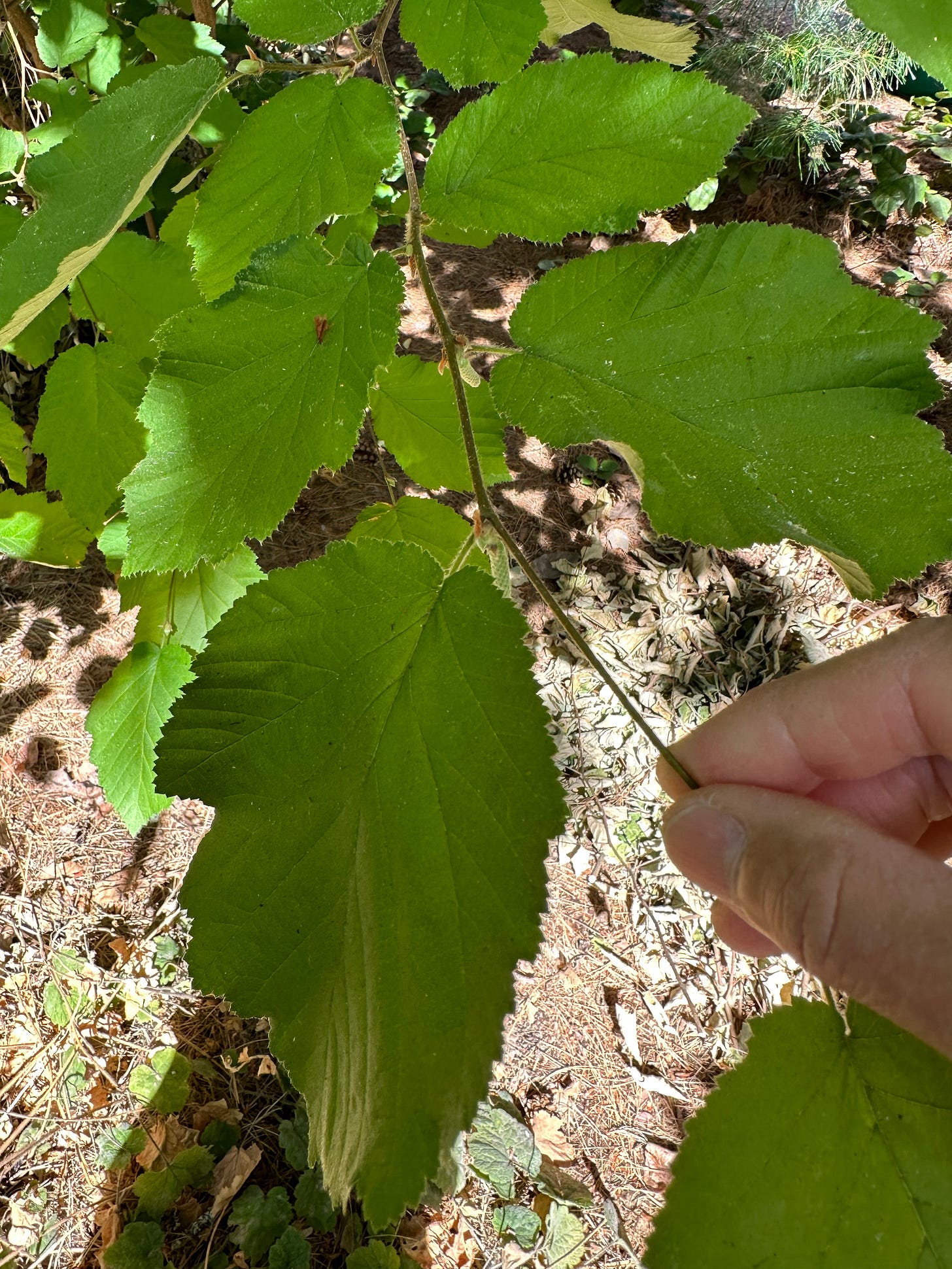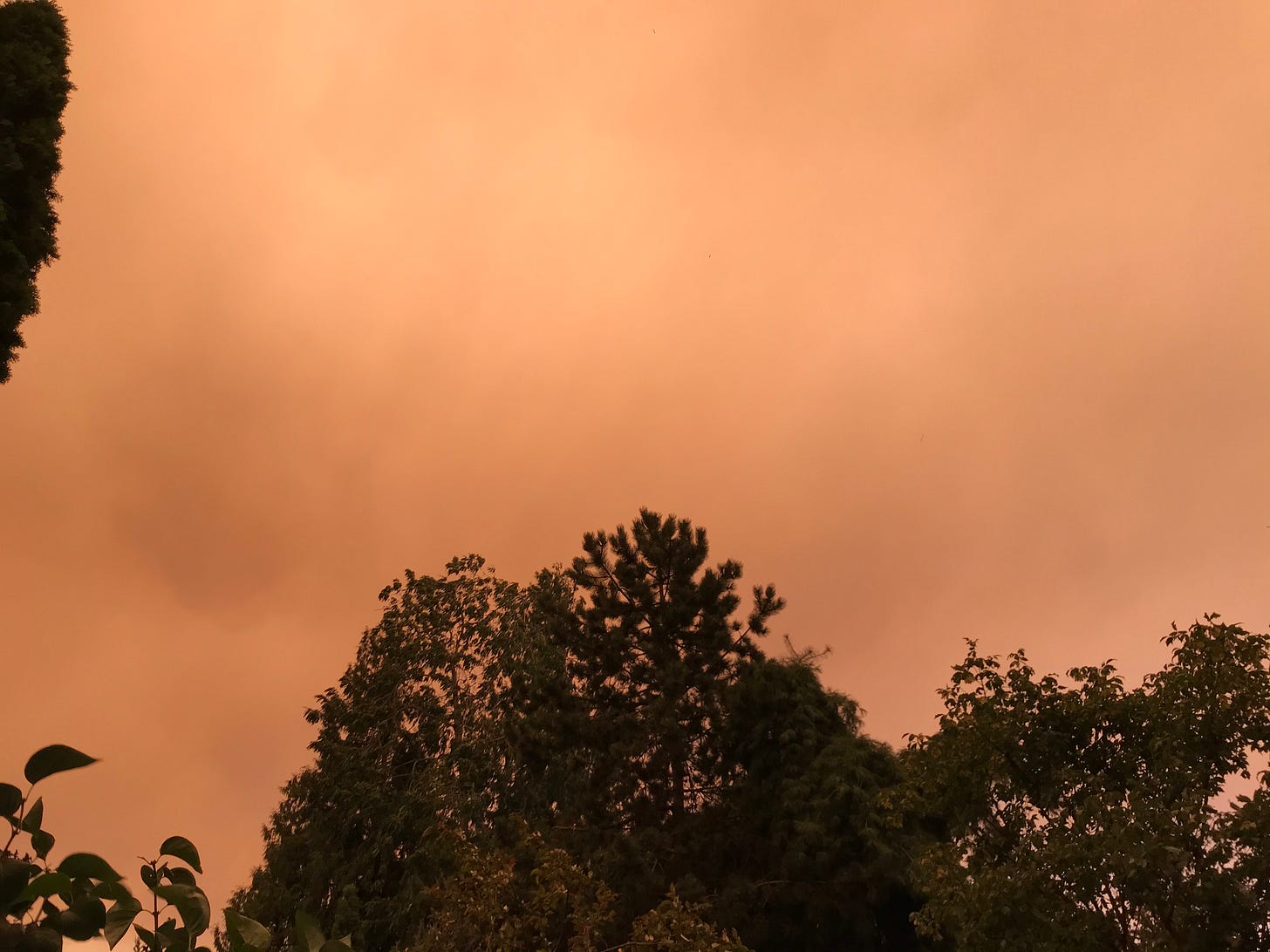When the Woods Come to You
Part I, August 14-15, 2023
I squat down and reach in, brushing past downy leaves that instantly release a slightly sweet and grassy scent of a natural insect repellent, and gently press my finger to each of the three tomatoes to test their readiness. As promised by their name—“Persimmon”—they are vibrant but not raucous, and definitely not harsh. And very much not a primary red. In fact, I planted this solely based on the anticipated color—as a food, I don’t find the tomato particularly thrilling—and it does not disappoint.
I pick one tomato, harvest a few white celery stalks, half of the remaining arugula, a few young Swiss chard leaves, and bunches of longevity spinach. With temperature at 104F, salad for dinner seems the obvious choice, and half moon wedges of the tomato cheer up a simple meal.

As if in competition, the atmosphere is draped in a gossamer veil tinged persimmon on this mid-August morning. The luminous glow is pleasing, but not welcomed. An advisory is issued by DEQ due to higher levels of ozone; I am relieved that it is “just” smog.
I watch the sky and sniff the air for signs that the forests are coming to us—in the form of ash when they burn, carried by the wind. Unlike Birnam Wood that comes to Macbeth, our forests are coming not as a deception nor a purposeful plan, but as a guileless reaction to our actions and inactions, and they are massively more destructive and deadly.

We moved to this neighborhood in 1991, delighted for the 17 acres of naturalized woods a block away, the groves of Douglas firs standing here and there as houses were built around them, and the undeveloped wooded lot right next door. A kitchen view of Mt. Hood covered in snow year-round opened up when the wooded lot was cleared and a house built. I recall that first year when there was no summer rain…sometime in the mid-1990s. There was a ban on watering lawns. An Oregonian columnist drove around in the dark of night—in a gas car—looking for homeowners watering illegally and wrote about it in her column. No rain in the summer, that was a big deal then. And a gas-consuming car, not yet a big deal to the average person, although scientists had known since the late 1800s that burning fossil fuel would bring about the warming of the planet’s atmosphere.
No rain in the summer, that was a big deal then. And a gas-consuming car, not yet a big deal to the average person, although scientists had known since the late 1800s that burning fossil fuel would bring about the warming of the planet’s atmosphere.
Now, 30+ years later, the new normal is that the Willamette Valley has a Mediterranean climate and there’s no precipitation in the summer. The new normal is 100+ Fahrenheit for a few days each year. The new normal is Mt. Hood not snow-capped comes August.
The new normal says we watch for persimmon skies and inhale the air for signs that the woods are coming for us.
Part II, Now
I started to replace the grass with trees and shrubs just about the minute we moved in. Although I hadn’t focused on PNW natives then, I have managed to create a garden that hosts many nesting birds. The soil is rich with leaf litter, compost, and mulch. My goal has always been to have a wooded garden that requires little work—hahaha!—with plants that should seed and raise themselves, just like the wildwoods.
It’s a familiar tale of woe, but I have had a lot of trees and shrubs do exactly that: English hawthorns, hollies, English laurels, Portuguese laurels, black walnuts, and the ever-present Himalayan blackberries (aka Armenian blackberries). Once I started to remove these plants, there were few volunteers that I could keep. An alder and a Western red cedar were both too close to the house and were also removed. (I have had volunteer vine maples and flowering currents, but they likely seeded themselves from parents I planted. The low-growing natives sword fern, lady fern, fringecup, fireweed, and snowberry have all been gifted to us by the wind or the birds, and have done well.)
In the spring of 2021, I discovered a hazelnut, aka filbert, growing in a corner under a pine and a rhododendron grown to a tree; it likely arrived via a squirrel from the woods a block away. I was ecstatic—the forest had arrived in a living tree!

A year prior, in 2020, I collaborated with Peter Wimberger, an evolutionary and conservation biologist and professor at University of Puget Sound, to create an artist’s book—Castor and Sapient—on beaver habitat restoration, part of Science Stories sponsored by UPS. One of the books I read/listened for my research was Braiding Sweetgrass by Robin Wall Kimmerer.
That COVID summer, after a few years of waffling, I finally made the decision to pull up some Vinca minor planted back in 1991. I had liked the evergreen ground-cover with little periwinkle flowers, it had provided shelter for small critters but also made it impossible to repair my drip system that required periodic maintenance here and there. I listened to Braiding Sweetgrass as I worked. With Kimmerer’s accomplished and graceful words in my ear, my plan to dig up enough Vinca to make the repairs turned into a complete removal. My labor felt correct—righteous even—and by the time I finished the book and the Vinca was gone from under the canopy of trees, I’d had a conversion experience.
I started to add PNW natives to my garden as I continued to learn about ecology and habitat restoration. And I set out to learn more about my volunteer hazelnut.
My labor felt correct—righteous even—and by the time I finished the book and the Vinca was gone from under the canopy of trees, I’d had a conversion experience.
The Willamette Valley produces 99% of the hazelnuts in the US; while there are PNW native hazelnut trees, the commercial hazelnut is an introduced European species with larger, free falling nuts. My neighborhood of West Portland Park had been clearcut back in 1889, and by early 1900s, the area was filled with dairies, orchards, and flower & tree farms, including hazelnut orchards. The descendants of those introduced trees continue to sprout and grow in our woods, and the only hazelnuts I’d ever seen had been the introduced nuts.
The differences among the hazelnut tree varieties are subtle, with the most pronounced being the the number of catkins per node and shapes of the nuts themselves—husks of the N. American nuts have elongated tubular ends called “beaks,” and the Western nuts have slightly shorter beaks than the Eastern nuts.
Good luck finding the nuts before the squirrels though. After two summers of watching for an actual beaked hazelnut (the native Corylus cornuta var. californica, the Western beaked hazelnut), I managed to spot a lone nut on the edge of a narrow stand of woods on PCC Sylvania campus. I squealed “look at that, Aster!” Never one to take commands well, she ignored me and continued to sniff the ground for possible treats. I further confused the poor dog when, like a yoyo, I repeatedly returned to the tree for another look, another photograph. I eventually left the nut for some lucky squirrel. When I returned the next day, it was gone.
I compared the leaves and twigs of my hazelnut against the PCC Sylvania specimen; I looked at so many videos produced by foresters and educators up and down the West Coast; I dissected the table put out by the Native Plant Society of Oregon (p14 of this PDF). And still, other than the fact that my specimen has mostly single catkin per node, I’m not absolutely confident that I have the native Western beaked hazelnut. It takes 8 years for a hazelnut grown from seed to produce fruit, so I must be patient.
I squealed “look at that, Aster!” Never one to take commands well, she ignored me and continued to sniff the ground for possible treats.
Will I keep the tree if it turns out to not be the native hazelnut? I don’t know, and I probably have a few years before I have to decide. Until then, I will remain hopeful that the forest is coming to me in the very best way possible.




